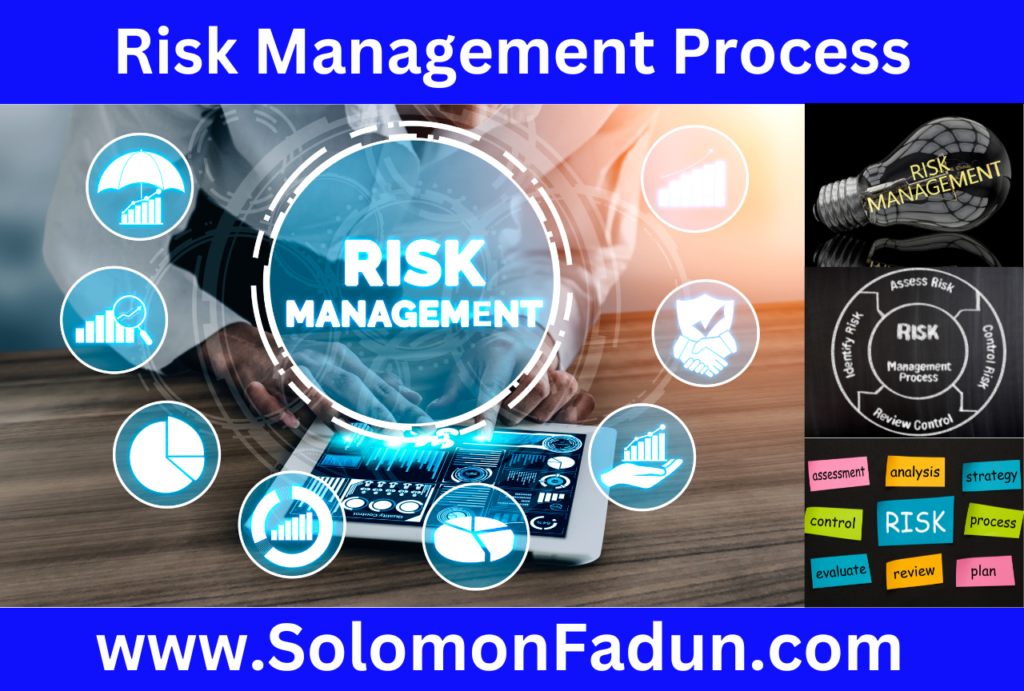Risk Management Process &
How To Improve Risk Management Process

This post discusses the risk management process and how to improve the risk management process in an organisation.
WHAT IS RISK MANAGEMENT?
Risk management is a scientific approach to dealing with risks by anticipating possible losses and designing and implementing procedures that minimise the risks and financial impacts of the losses that occur. Risk management is identifying, evaluating, and prioritising risks followed by integrated and economical application of resources to reduce, observe, and control the probability or impact of unfortunate events or maximise opportunities.
Risk management is a crucial business practice that helps businesses identify, evaluate, track, and improve the risk mitigation process in the business environment. Companies of all sizes practise risk management. Small businesses manage risks informally, but large organisations may embrace a holistic risk management approach known as enterprise risk management. Companies want to ensure stability as they grow. Managing the risks affecting the firm is a critical part of this stability.
Knowing about the risks that can affect the business can result in losses for the organisation. Being unaware of a competitive risk can result in a loss of market share, being ignorant of financial risk can result in financial losses and being aware of a safety risk can result in an accident. Risk management requires time and money but can be manageable and effective. It will be more likely to be employed and maintained if it is implemented gradually over time.
RISK MANAGEMENT PROCESS
Implementing a risk management process is vital for any organisation. Good risk management can be something other than resource-intensive or difficult for organisations to undertake or insurance brokers to provide to their clients. The risk management process can be rewarding with formalisation, structure, and a strong understanding of the organisation. The risk management process is a framework for the actions that should be taken.
Five basic steps are involved in a risk management process. These steps are known as the risk management process. It begins with identifying risks, and analysing risks, then the risk is prioritised, a solution is implemented, and finally, the risk is monitored. In manual systems (which is a situation where risk management software is not engaged), each step involves documentation and administration. Risk management is not just about identifying risks; it is also essential to know how to manage them. The key is to have a basic understanding of the process and to move towards its implementation.
STEPS OF A RISK MANAGEMENT PROCESS
Here are the five steps of a risk management process:
Step 1: Identify potential risks,
Step 2: Analyse the risk,
Step 3: Evaluate or Rank the Risk,
Step 4: Treat the risk, and
Step 5: Monitor results and review the risk.
STEP 1: Identify Potential Risks
The question that should be addressed at the risk identification stage is: “What can go wrong?”
The first step in preparing a risk management plan is identifying potential business risks. The first step is to identify the risks the company is exposed to in its operating environment. There are several types of risks: operational, financial, strategic, reputational, legal, market, and regulatory. Understanding the scope of possible risks will help an organisation develop realistic, cost-effective strategies for dealing with them.
STEP 2: Analyse the Risk
At this stage, you should measure the frequency and severity of each identified risk. Questions that should be addressed at the risk analysis stage are: “What is the likelihood of a risk occurring, and if it did, what would be the impact?”
After identifying potential risks, the next step is to analyse the risk. The scope of the risks identified at the first stage of the risk management process must be determined and analysed. The essence of risk analysis is to measure the frequency and severity of a risk.
STEP 3: Evaluate or Rank the Risk
Questions that should be addressed at the risk evaluation stage are: “What are the potential ways to treat the risk, and of these, which strikes the best balance between being affordable and effective?”
The essence of risk evaluation is to examine alternative options or solutions. The key here is to find the solution that strikes the best balance between affordability and effectiveness. The choice of solution needs to bring a good return on investment. Risks should be ranked and prioritised. Most risk management solutions have different categories of risks, depending on the severity of the risk.
STEP 4: Treat the Risk
Having determined what risk to manage, the company must evaluate the process to be adopted to treat or control each risk identified at the first stage of the risk management process. The organisation should select the solution most likely to achieve desired outcomes. Suitable risk treatment strategies should be implemented at this stage of the risk management process.
5. Monitor Results and Review the Risk
Risk management is a process, not a project, that can be “finished” and forgotten. The organisation, its environment, and its risks are constantly changing. Hence, the risk management process should be reviewed and updated regularly. A risk management plan must be made and remembered. As the organisation and its landscape continuously change, so does the firm’s risk exposure. New risks may present themselves, or adopted policies may become too in-depth or inadequate. The company’s method to control a particular risk may need to be more effective. Determine whether the initiatives are adequate and whether changes or updates are required. Sometimes, the team may have to start with a new process if the implemented strategy is ineffective.
STEPS TO CONTROL AND MANAGE A BUSINESS RISKS
Treating risks involves working through options to deal with unacceptable risks to the business. Unacceptable risks range in severity – some risks will require immediate treatment while others can be monitored and treated later.
Risk analysis and evaluation will help the company prioritise the risks that must be treated. When the company is developing a plan for treating potential risks, the following issues should be considered:
• Method of treatment,
• People who are responsible for the treatment of risks,
• Costs involved,
• Benefits of treatment,
• Likelihood of success, and
• Ways of measuring the success of a risk treatment.
The firm’s risk management plan should outline how and why the company has decided to treat risks. It is essential to regularly review the risk management plan to consider any new risks associated with changes in the company or improvements in techniques for treating risks.
TREATMENT OF BUSINESS RISKS
Here are the five options for treating risks and their meaning:
1. AVOID THE RISK
This is a risk-avoidance strategy. To avoid risk, the organisation must not participate in that activity. If a risk is perceived as too dangerous to be worth the benefit, the company can prevent it by not taking the risky action or discontinuing the practice. A firm may decide not to proceed with an activity likely to generate risk. Alternatively, the company may consider other ways to achieve the same outcome that does not involve the same risks.
2. REDUCE THE RISK
This is a risk reduction strategy. Risk control involves prevention (reducing the likelihood that the risk will occur) or mitigation, thereby reducing its impact if it does happen. Risk prevention entails formulating policies and procedures that minimise the possibility that the risk will occur (the frequency). For example, the company could implement hourly inspections for hazards in a setting prone to customer slips, trips, and falls. Risk control also entails mitigating risk by creating policies and procedures that decrease the impact risk will have if it occurs (the severity).
3. TRANSFER THE RISK
This is a risk transfer strategy. Risk transfer involves giving responsibility for adverse outcomes to another party, as when an organisation purchases insurance. Risk transfer entails passing the liability and risk to someone else through waivers, contracts, or insurance policies. The company will then hold another party responsible through insurance, outsourcing, joint ventures, and partnerships.
4. PURCHASE SUITABLE AND ADEQUATE INSURANCE POLICIES
A typical example of risk transfer is when the company buy an insurance policy to cover the financial loss of the risk if it occurs. The organisation should speak to insurance brokers or insurers to determine if the firm’s risks are insurable.
5. ACCEPT THE RISK
This is a risk acceptance or risk retention strategy. An organisation may accept a risk if it cannot be avoided, reduced, or transferred. Other risks may be extremely unlikely and, therefore, too impractical or expensive to treat. Acceptance means taking the risk as it is. Accepting the risk means deciding that some risks are inherent in doing business and that the benefits of an activity outweigh the potential risks.
See the full video on Risk Management Process: https://youtu.be/owKf1C4N2LA

VIDEO TIMESTAMPS
00:00 – Introduction
00:37 – Meaning of risk management
02:14 – Risk management process
02:43 – Steps of a risk management process
14:32 – Five steps to control and manage organisations risks
15:47 – Treatment of business risks
20:42 – Conclusion
